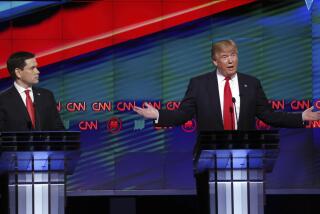Greenspan Wisely Tilts Toward Growth
- Share via
With the appointment of Alan Greenspan, the Federal Reserve Board under President Reagan is certain to go down in history as the most intriguing political paradox since Dwight D. Eisenhower created the Warren court.
This most conservative Administration in decades has already packed the Fed with five new governors whose pro-growth monetary policies have delighted progressive Democrats, even if few of us are willing to admit it in public.
On the surface, Greenspan may seem like the first truly conservative Federal Reserve appointment that Reagan has made. Look at the particulars: His history runs deep in the GOP’s anti-inflation mainstream; he has made Wall Street his home since leaving the Gerald R. Ford White House a decade ago; well-placed sources tell us that Paul A. Volcker himself suggested Greenspan as the best replacement, and, finally, Greenspan was undoubtedly chosen with a wary eye on financial markets that had developed a personality cult around the outgoing chairman.
However, my bet is that Greenspan will turn out to be one more piece of good news for jobless workers, developing nations and the international economy. He is much more than the sum of his resume. To talk with Greenspan is to realize that he carries in his stomach a rumbling fear of recession, a visceral understanding that an economic slump could rip the already shredded band-aids from the battered world economy. That fear of the abyss could make Greenspan an unlikely hero for progressive Democrats in the coming months.
He comes on stage at the most precarious economic moment of the decade. The easy years of low inflation are behind us as the dollar sinks. World economic growth has stagnated. Bankers and debtors are squaring off for another fight (under new rules still being written by the banks), and the international reform effort launched by Treasury Secretary James A. Baker III in 1985 is sputtering to a halt. We have reached a political, emotional and economic gridlock that threatens to plunge us into a new recession at a time when we can least afford it.
Greenspan’s work in the decade since leaving the Ford Administration has made him acutely aware of the danger that a recession holds for us now. He has a first-hand feel for the debts that small and medium-size companies owe. He knows intimately about the financial squeeze that disinflation has brought to middle America, and he fears that even a brief slowdown now could plunge many well-run firms into bankruptcy.
That sets him apart from any Fed chairman in recent history. Working with Greenspan convinces me that his intuitive grasp of real-life business problems is bone deep, and not the stuff of theoretical chalk talks and detailed Federal Reserve staff briefing papers. It is this “feel” that will quickly make Greenspan an important force for economic growth in the United States and abroad.
No one is pretending that Greenspan will become a working-class hero. Fed chairmen are not going to be fiery orators or cheerleaders for a new wave of income redistribution. We are not even talking about huge shifts in monetary policy here. What counts in a Fed chairman is the undercurrent, the subtle signals that he sends to market participants, business planners and policy-makers. For the first few months, in public, Greenspan will sound a lot like Volcker. Write it off as an occupational hazard.
Just like any good politician--and the best Fed chairmen are consummate politicians--Greenspan will have to solidify his “base.” That base is Wall Street, and he knows that the financial markets will be watching closely for signs that he is dedicated to fighting inflation. We can expect tough rhetoric from him on that front. Fine. Let him talk for Wall Street. What counts is if he acts for America.
His most important step will be the private agenda he sets out with other members of the Federal Reserve Board, particularly Vice Chairman Manuel Johnson and Gov. Robert Heller, who with Greenspan will form the intellectual core of the new board. Greenspan has to move quickly to establish this bloc because investors, corporate planners and speculators will be watching carefully to see who is in control. Remember, the last year of Paul Volcker’s tenure was marred by rumors of impending revolt by the Fed governors.
In the first few weeks of Greenspan’s tenure, I believe that he will put all that behind him. Greenspan, Johnson and Heller will reach a quiet understanding about the “tilt” of Fed policy. The question that they face is easy: As the pressure to raise interest rates continues to build, do we tilt toward promoting growth or toward restraining inflation? There are many corollaries and complications here (the value of the dollar, pressure from West Germany and Japan, etc.), but from that one question all else follows.
The answer is not an equation but a state of mind. It may not look like much in public, but it will have a profound effect on every macroeconomic move made in the final 18 months of the Reagan Administration. A tilt toward growth now would give U.S. factories the breathing room that they need to make long-overdue capital investments. It would be an important part of the fall push to revive the economic coordination effort of the Western democracies and, most important, it could stave off a recession that would wreck havoc on U.S. farmers, Third World debtors and the fragile budget compromise now being crafted in Washington.
Greenspan knows all this. That is why he--and the board--will tilt toward growth, and that is why he deserves the support of Democrats at this critical juncture.
More to Read
Get the L.A. Times Politics newsletter
Deeply reported insights into legislation, politics and policy from Sacramento, Washington and beyond. In your inbox three times per week.
You may occasionally receive promotional content from the Los Angeles Times.










